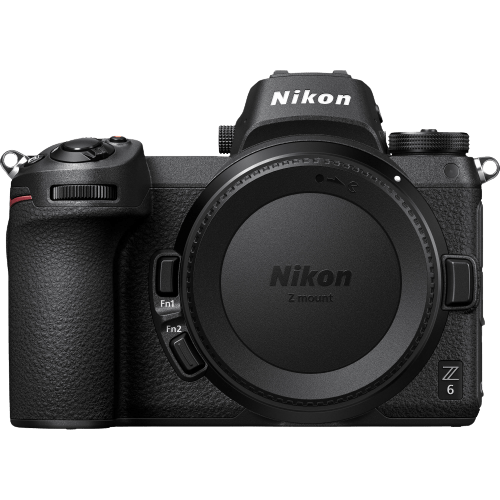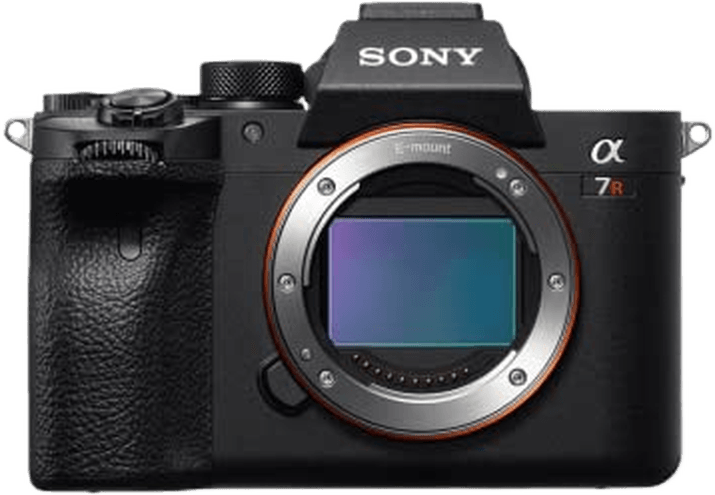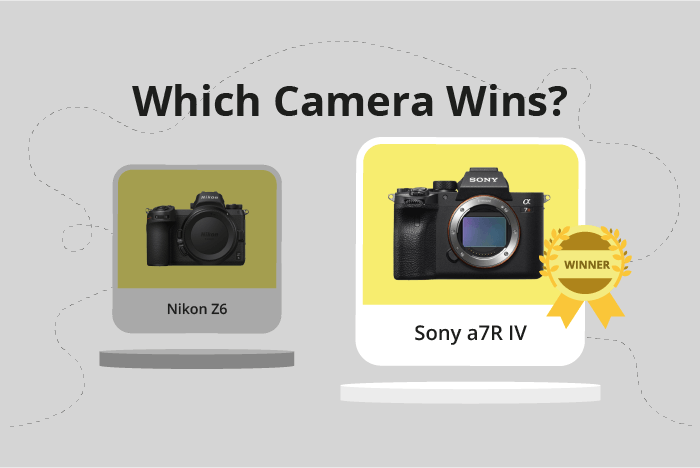Nikon Z6 vs Sony a7R IV Comparison
Nikon Z6

Sony a7R IV

The Sony a7R IV outperforms the Nikon Z6 with a score of 84/100 compared to 81/100. Both cameras are mirrorless, released a year apart, with the Nikon Z6 in 2018 and the Sony a7R IV in 2019. They share similar sizes and weights, with the Sony a7R IV being slightly smaller and lighter.
The Sony a7R IV justifies its higher score with a higher launch price of $3500, offering superior performance and features. On the other hand, the Nikon Z6, priced at $2000, provides great value for its price, making it a more budget-friendly option.
In this comparison, the Sony a7R IV emerges as the better camera due to its higher score, while the Nikon Z6 remains a solid choice for those seeking a more affordable option.
Nikon Z6 vs Sony a7R IV Overview and Optics
The Sony a7R IV wins the optics comparison with a score of 85/100, while the Nikon Z6 scores 83/100. Both cameras share several specifications, such as a CMOS sensor, full-frame sensor size, and image stabilization. They also have their respective lens mounts: Nikon Z for the Z6 and Sony FE for the a7R IV.
The Sony a7R IV outperforms the Nikon Z6 in terms of megapixels and sensor quality. With a staggering 61.2 megapixels, the a7R IV captures highly detailed images, while the Z6 has 24.5 megapixels. The a7R IV’s DXOMARK sensor score is 99, which is higher than the Z6’s score of 95. These factors contribute to the a7R IV’s superior image quality.
On the other hand, the Nikon Z6 has a faster shooting speed of 12 frames per second (fps), compared to the a7R IV’s 10 fps. This makes the Z6 more suitable for capturing fast-moving subjects and action photography. Additionally, the Z6 uses the Expeed 6 processor, while the a7R IV uses the Bionz X processor. However, the difference in processors does not significantly impact the optics performance of these cameras.
In terms of optics, the Sony a7R IV excels due to its higher megapixels and sensor performance, making it ideal for photographers seeking the best image quality possible. The Nikon Z6, while slightly inferior in optics, offers a faster shooting speed that may appeal to those who prioritize capturing fast-paced action. Both cameras are strong contenders in their respective areas, and the choice ultimately depends on the photographer’s preferences and needs.
Nikon Z6 vs Sony a7R IV Video Performance
The Nikon Z6 outperforms the Sony a7R IV in video capabilities, with a video score of 83/100 compared to the Sony’s 70/100. Both cameras share common specifications, such as 4K max video resolution and 3840 x 2160 max video dimensions. Additionally, they both have built-in time-lapse functionality.
The Nikon Z6 excels in its video frame rate, offering 60fps, which is double the Sony a7R IV’s 30fps. This higher frame rate results in smoother video playback and provides more flexibility for slow-motion footage. The Z6’s superior video performance is evident in its 13-point higher score, making it a more suitable choice for videographers and content creators.
While the Sony a7R IV falls short in video frame rate, it still offers quality video capabilities. Its 4K resolution and built-in time-lapse functionality make it a viable option for those who prioritize photography but also want the flexibility to capture video. However, for users focused on videography, the Nikon Z6 is the clear winner.
Considering the differences in video capabilities, the Nikon Z6 is the better choice for videographers and those who require higher frame rates. The Sony a7R IV, while not as strong in video performance, remains a suitable option for those who want both photography and video features. Ultimately, the choice depends on the user’s priorities and preferences in their camera’s capabilities.
Nikon Z6 vs Sony a7R IV Features and Benefits
The Nikon Z6 emerges as the winner in the features comparison with a score of 87/100, while the Sony a7R IV scores 83/100. Both cameras share several specifications, such as touchscreen capability, absence of GPS, and the presence of WIFI and Bluetooth connectivity.
The Nikon Z6 surpasses the Sony a7R IV in terms of screen size and resolution, boasting a 3.2-inch screen with 2,100,000 dots. This larger and higher-resolution screen provides a clearer and more detailed view of images and menus, enhancing the overall user experience.
On the other hand, the Sony a7R IV has a unique advantage with its flip screen feature, which is absent in the Nikon Z6. This flip screen allows for easier composition and shooting from various angles, making it more versatile for photographers who need flexibility in their shooting positions.
Despite the advantage of the flip screen, the Nikon Z6’s larger screen size and higher resolution make it the better camera in terms of features. The Sony a7R IV’s flip screen is a useful addition, but it does not outweigh the benefits provided by the Nikon Z6’s superior screen specifications.
Therefore, the Nikon Z6 stands out as the superior camera in this comparison, offering a better viewing experience and overall feature set. The Sony a7R IV, while still a strong contender, falls slightly short in comparison due to its smaller screen size and lower resolution.
Nikon Z6 vs Sony a7R IV Storage and Battery
The Sony a7R IV outperforms the Nikon Z6 in storage and battery with a score of 79/100 compared to the Z6’s 35/100. Both cameras have USB charging capabilities, allowing for convenient power management.
The a7R IV’s advantages include two memory card slots and compatibility with SD, SDHC, and SDXC (UHS-II) cards. This versatility offers more storage options and backup possibilities. Additionally, the a7R IV boasts a battery life of 670 shots, significantly longer than the Z6’s 310 shots, thanks to its NP-FZ100 battery.
The Nikon Z6, on the other hand, has only one memory card slot and accepts XQD cards. While this limits storage expansion, XQD cards provide faster read and write speeds. The Z6’s EN-EL15b battery, however, falls short in comparison to the a7R IV’s battery life.
Taking these factors into account, the Sony a7R IV emerges as the superior choice for storage and battery performance, offering greater flexibility and longevity. The Nikon Z6’s advantage lies in the speed of its XQD cards, but it does not outweigh the benefits provided by the a7R IV.
Nikon Z6 vs Sony a7R IV – Our Verdict
Are you still undecided about which camera is right for you? Have a look at these popular comparisons that feature the Nikon Z6 or the Sony a7R IV:

